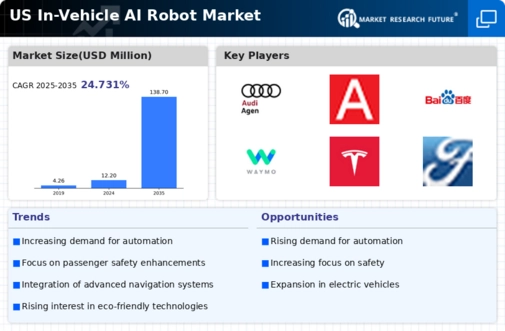The US In-Vehicle AI Robot Market is rapidly evolving, demonstrating significant competitiveness driven by advancements in artificial intelligence, automation, and mobility solutions. This market is characterized by a diverse range of players that incorporate cutting-edge technologies to enhance vehicle functionality, improve user experience, and foster safer driving environments. As consumer demand for more intelligent, integrated, and responsive in-car systems rises, companies are investing heavily in research and development, partnerships, and strategic alliances. The competitive landscape is also shaped by regulatory policies that aim to improve safety and promote innovative transportation solutions.
Hence, understanding competitive insights in this sector is vital for stakeholders seeking to navigate through market dynamics effectively.Toyota Motor Corporation has established a significant presence in the US In-Vehicle AI Robot Market, leveraging its long-standing reputation for reliability and innovation. The company emphasizes enhancing its vehicle offerings through advanced AI systems that provide seamless integration, smart navigation, and enhanced safety features. Notably, Toyota's strength lies in its extensive research and development capabilities, allowing it to pioneer innovative solutions that cater to changing consumer preferences.
The brand's commitment to sustainability and environmental stewardship also resonates with growing consumer interest in eco-friendly technology. These factors contribute to Toyota's robust market position, enabling it to maintain a competitive edge in the rapidly growing field of in-vehicle AI technology. Audi AG is a well-recognized player in the US In-Vehicle AI Robot Market, known for its commitment to premium automotive experiences and technological advancement. The company offers an array of key products and services that incorporate AI capabilities for improved user interaction and driving assistance.
With an emphasis on high-quality craftsmanship and luxury, Audi delivers sophisticated in-vehicle systems that enhance connectivity and automate routine functions. Their strategic investments in AI research and collaboration with tech firms reflect Audi’s commitment to being at the forefront of automotive technology. The company also actively pursues mergers and acquisitions as part of its growth strategy to enhance its technological capabilities in the US market. This positions Audi as a formidable competitor, capable of leveraging its brand reputation while continually adapting to new trends and consumer demands in the sphere of in-vehicle AI solutions.



















Leave a Comment